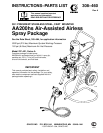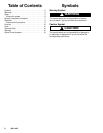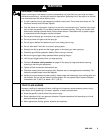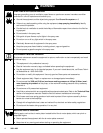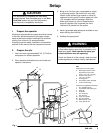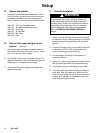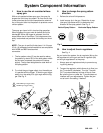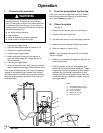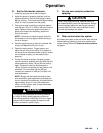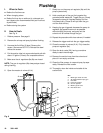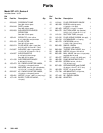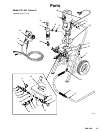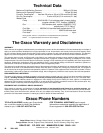
3
308-460
WARNINGWARNING
SKIN INJECTION HAZARD
Spray
from the gun, hose leaks or ruptured components can inject fluid into your body and cause
extremely serious injury
, including the need for amputation. Splashing fluid in the eyes or on the skin
can also cause can also cause serious injury
.
D
If a skin injection occurs, get emergency medical care at once. Do not treat as a simple cut. T
ell
the doctor exactly what fluid was injected.
D
Give the doctor this information: Injection into the skin is a traumatic injury
. T
reat the injury surgi
-
cally as soon as possible. Do not delay treatment to research toxicity
. T
oxicity is a concern with
some exotic coatings injected directly into the blood stream. Consultation with a plastic surgeon
or reconstructive hand surgeon may be advisable.
D
Do not point the spray gun at anyone or any part of the body
.
D
Do not put hand or fingers over the spray tip.
D
Do not stop or deflect fluid leaks with your hand, body
, glove or rag.
D
Do not “blow back” fluid; this is not an air spray system.
D
Always have the tip guard and the trigger guard on the spray gun when spraying.
D
Check the gun dif
fuser operation weekly
. Refer to the gun manual.
D
Be sure the gun trigger safety operates before spraying the gun.
D
Lock the gun trigger safety when you stop spraying.
D
Follow the
Pressure relief procedure
on page 8 if the spray tip clogs and before cleaning,
checking or servicing the equipment.
D T
ighten all fluid connections before each use.
D
Check the hoses, tubes and couplings daily
. Replace worn or damaged parts immediately
. Per
-
manently coupled hoses cannot be repaired.
D
Handle and route hoses and tubes carefully. Keep hoses and tubes away from moving parts and
hot surfaces. Do not use the hoses to pull equipment. Do not expose Graco hoses to tempera
-
tures above 180
_F (82_
C) or below –40
_F (–40_C).
TOXIC FLUID HAZARD
Improper
handling of hazardous fluids or inhaling toxic fumes can cause extremely serious injury
,
even death, due to splashing in the eyes, ingestion, or bodily contamination.
D
Know the specific hazards of the fluid you are using.
D
Store hazardous fluid in an approved container
. Dispose hazardous fluid according to all local,
state and national guidelines.
D W
ear appropriate clothing, gloves, eyewear and respirator
.



